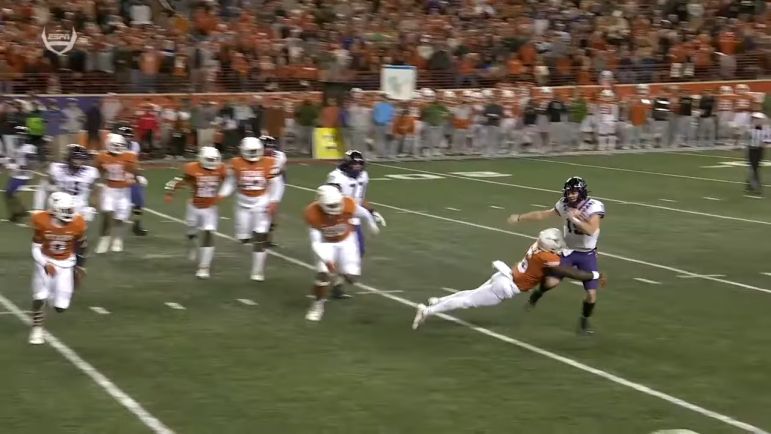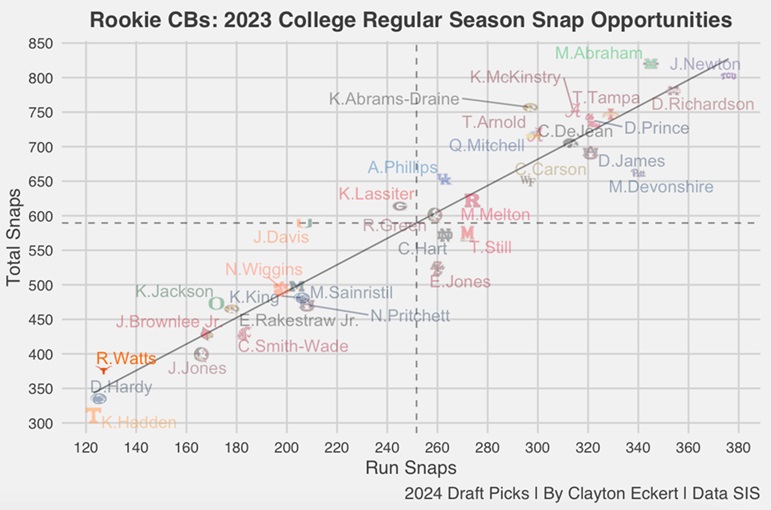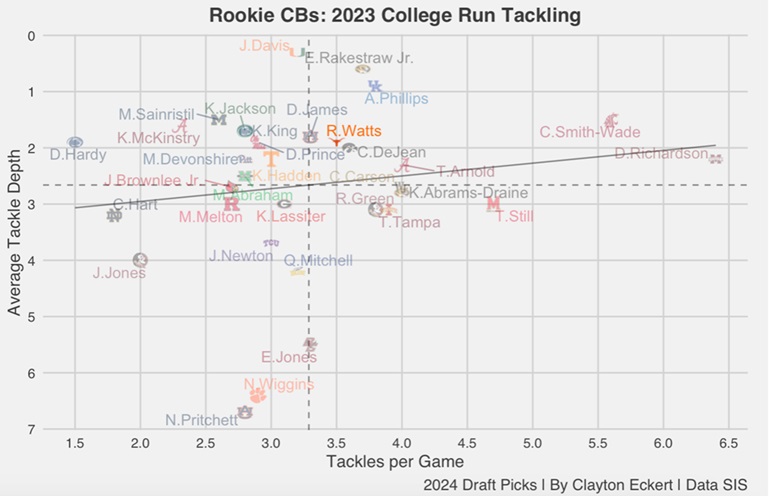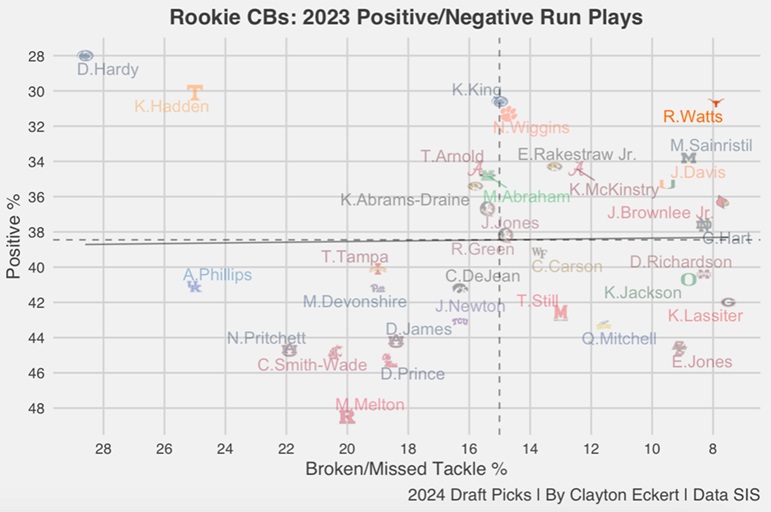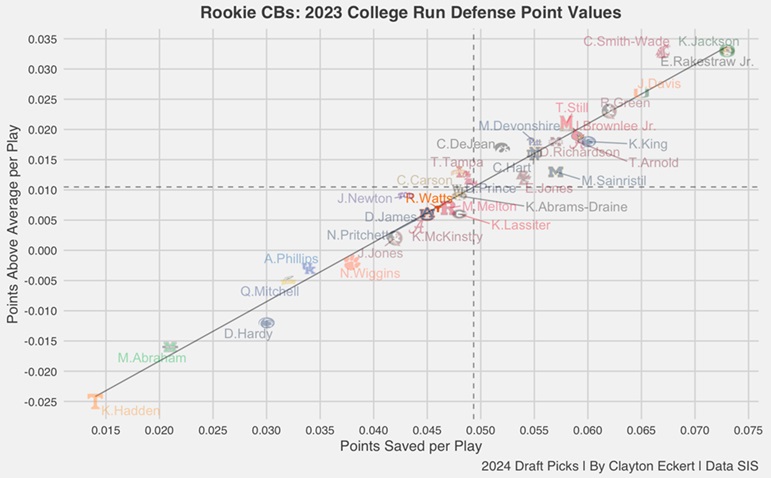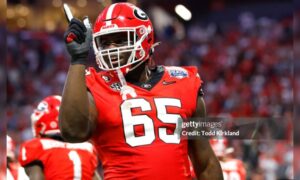Continuing the series, I wanted to move back to cornerbacks where the Pittsburgh Steelers selected Ryan Watts in the sixth round. He was listed as a defensive back and worked with the safeties early in OTAs but his position wasn’t cemented by the team. Today’s goal is to look at and provide stat context for the position in run defense using Sports Info Solutions (SIS).
The data in this study looks at their final college season in 2023, focusing on the players who heard their names called in the draft, and two players were excluded due to SIS not tracking smaller schools or the Canadian Football League. The goal is to see how Watts stacked up among his peers.
Let’s start with rush snaps and total snaps to get a gauge of the players opportunities, and how often they were on the field for their squads last season:
Watts lands on the bottom left, emphasizing less snap opportunities than the vast majority of CBs in the 2024 draft. He ranked 31st out of the 33 qualifiers in total snaps (376) and run snaps (127). Notably, Watts suffered a hamstring injury mid-season, forcing him to miss three games.
We also see he landed slightly above the trendline (horizontal line), meaning he had a lower percentage of run snaps than other situations compared to his peers. Important context as we dive deeper.
Next, let’s look at a very important aspect of being a quality run defender – tackling. The chart below looks at the players tackles per game and average tackle depth, with the latter suggesting quality play up front and attacking the line of scrimmage:
While the quantity of plays was low, we can see the quality as a tackler was encouragingly above-average. Watts averaged 3.5 tackles per game which ranked 12th, along with a healthy 1.9 average tackle depth that tied for an even better tenth.
Both are very encouraging, especially when recalling his very low snap totals, providing quality and quantity in his opportunities. Also important is pre-snap alignment, where Watts had 316 wide corner reps and 52 in the box being the bulk of his contributions. His average tackle depth didn’t suffer despite playing outside corner often.
This next view attempts to weigh positive and negative plays, using broken and missed tackle rates (negative plays) along with SIS positive play %, which is the rate of run plays with the player on the field resulted in a positive expected points added (EPA), with lower percentages being the best:
Even better news here. Watts fared extremely well in these metrics, with an awesome 7.9 missed tackle rate that was third-best among qualifying cornerbacks and a 30.7 positive percentage that ranked fourth.
Yes, the lower number of run snaps needs to be taken into account, but Watts showed an ability to provide great results as a run defender in limiting run plays quickly and as a sound tackler.
To close, here is a more total view of the players in the run game:
- Points Saved per Play: The total of a player’s EPA responsibility on run plays using the Total Points system that distributes credit among all players on the field for a given play, with positive numbers being good. Totals are scaled up to map to the average points scored or allowed on a team level, with the player’s snap count determining how much to adjust. For run defense, that includes accounting for defenders in the box, blown blocks forced, broken tackles, turnovers, and turnover returns.
- Points Above Average per Play: using the same Total Points system and putting a number to their value above an average level player:
In this more complete view, we see Watts falls slightly below-average in these point values. One major factor is the low snap totals, seeing visual representation of his quality over quantity as mentioned earlier. More specifically, Watts ranked 22nd in points saved per play, and tied for 21st in points above-average per play.
Watts had some key contributions as a run defender in 2023. He ranked top five among the 33 qualifying corners in the 2024 draft in missed tackle rate (third) and positive percentage (fourth) most encouragingly.
He also posted strong marks in average tackle depth (T-tenth) and tackles per game (12th) despite an injury shortened season, which factored into slightly below average points above average (T-21st) and points saved (22nd) metrics.
The lack of sample size (third-lowest total and run snaps) can be looked at two ways, starting with the wonder if more reps, and/or a step up in competition would create a negative trend moving forward.
Personally, at least out of the gate, Watts would more likely play limitedly if he earns playing time as a rookie, and could result in a similar quality over quantity role. Hopefully that’s the case, and I can’t wait to see how it pans out.

